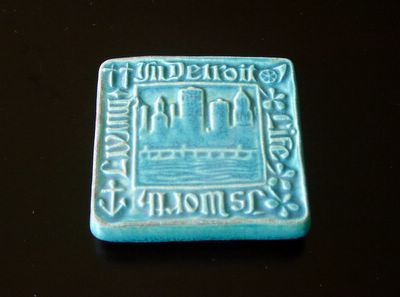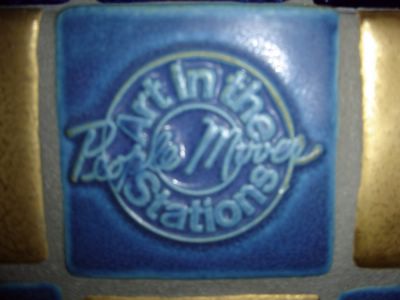Anyone that has spent time looking around and exploring Detroit will tell you that this Midwestern metropolis is full of hidden treasures. Besides the numerous places in and around the Detroit area that display Pewabic tiles and ornamentations, the famous pieces can be seen around the United States in places such as the National Shrine of the Immaculate Conception in Washington D.C. and Rice University's Science Building in Houston. Have a question or comment on this post?
From the Dequindre Cut, to the mansions of the Boston-Edison district, to the old Piquette Plant, and many others in between, Detroit is more than just a spot on the map - it's a 304-year-old city bursting with fascinating things to see and do.
One such place, Pewabic Pottery, is the spotlight of today's post.
The idea for Pewabic Pottery came about in the early 1900s after two Detroit neighbors - Mary Chase Perry, an artist, and Horace James Caulkins, a businessman - started an unlikely partnership.
Upon meeting and discussing their careers, Caulkins discovered that Perry, a well-respected china painter, was just the person to market his latest invention, the Revelation Kiln.
Although she certainly wasn't a dentist, Perry's art form did require heat, and having a portable form of it would make the traveling demonstrations of china painting she had been performing easier.
And, with that, it was settled - Perry would go to different cities and towns doing her demonstrations, and she would take Caulkins' kiln with her, showing others how to use it and then taking purchase orders for those interested in buying one.
In her new role as salesperson/demonstrator, Perry was extremely successful, as were sales of the kilns.
Art in the People Mover Station tile
This success continued for a few more years, but ended after Perry - who was spending all of her time either producing, instructing, or talking about china painting - grew tired of the artform, and decided to look for a new challenge. She found it a short time later when she chose to pursue ceramics.
Caulkins, who was now a close friend of Perry's, supported his business partner's decision to change her focus, and worked alongside her as she began experimenting with clay and glazing in a small stable on John R. in Detroit. 
Pewabic Pottery is located on East Jefferson Avenue and Cadillac
It was in this small space that Perry began developing the unique, iridescent sheens that later become her, and Pewabic Pottery's, signature characteristic.
The beautiful, original glazes, coupled with the rapid growth of the Arts and Crafts movement in the United States, brought Perry local and national acclaim. Before long, she was hired to produce tile installations and building ornamentations for structures throughout the city of Detroit, including the Guardian building, the DIA, the Main Branch of the Detroit Public Library, St. Paul's Cathedral, the Detroit Yacht Club, and countless others.
In addition, many notable members of society showcased Perry's tiles in their homes, especially those living in the Indian Village and Grosse Pointe communities.
Caulkins, thrilled with his partner's rapid success, suggested they find a local designer to create a building where Perry could produce, display, and train other artists in replicating her ceramic pieces.
Deeply involved with the newly-formed Society of Arts and Crafts that manifested in Detroit in 1906, Perry and Caulkins enlisted William Stratton, a notable Detroit architect and the Vice President of the Society at the time, to design their new place. Upon completion in 1907, the beautiful Tudor Revival style building on East Jefferson became the new home of Perry's ceramic works, and the soon-to-be Pewabic Pottery.
Pewabic Pottery
Pewabic, which is a Chippewa word meaning clay with a copper color, was the chosen name of the pottery company.
The years following the creation of the Pewabic Pottery Company saw an increased public interest in the Arts and Crafts style, a phenomenon that put Perry's unique tiles, vessels, and ornamentations in even higher demand.
In 1917, Ms. Perry - a graduate of the Cincinnati Art Academy - married William Stratton, the architect of the Pewabic building. She furthered her career in ceramics, and worked as a ceramicist and teacher at Pewabic, which - unlike the Arts and Crafts movement - had not suffered a decline. Perry Stratton's career continued to grow and, with the $100 sale of a vase to Detroit philanthropist Charles Freer in 1909, the Michigan native's career reached another peak - one that symbolized her immense craftsmanship and talent within the ceramics field.
Pewabic tiles were installed in this mural at the Times Square People Mover station in 1989
Continuing as an artist at the Detroit Pewabic Pottery Company into her later years, Mary Chase Perry Stratton expanded her roles as both instructor and leader when she began teaching at the University of Michigan and Wayne State University. She is credited with starting the ceramics department at U of M.
With the vast and numerous contributions she made to her field, it is no surprise that Perry Stratton was the recipient of the Charles Fergus Binns Medal in 1947, which is the highest honor one can receive in the ceramics field.
When she died in 1961, Mary Chase Perry Stratton was 94. Her business partner, Horace Caulkins, had been dead for a few years, as had his wife, which made Caulkins' son, Henry, the heir of Pewabic. Wanting to maintain and further Perry's life-long work, Henry deeded both the pottery and its grounds to Michigan State University, who ran the pottery as a teaching organization until the end of the 1970s.
The fireplace at the old children's library in the Main Branch of the Detroit Public Library is made of Pewabic Pottery. The ten squares going around the fireplace's edge each depict characters from popular children's stories, such as Hantzel and Gretel and Alice in Wonderland.
In 1981, a non-profit group was formed to take control of the pottery from MSU. Pewabic Pottery, Inc., still runs the pottery to this day, and has spent the last two and a half decades expanding the pottery's programs and defining its focus. Today, Pewabic Pottery is a working pottery that includes a museum, teaching exhibitions, and a small for-profit operation that sells reproductions of Perry's original ceramic works.
Mary Chase Stratton Perry was inducted into the Michigan Women's Hall of Fame in 1986 and Pewabic was added to the National Register of Historic Places in 1991.
E-mail me at girl.in.the.d@gmail.com
Saturday, August 27, 2005
Detroit's Pewabic Pottery
Posted by
Girl in the D
at
5:27 PM
![]()
![]()
